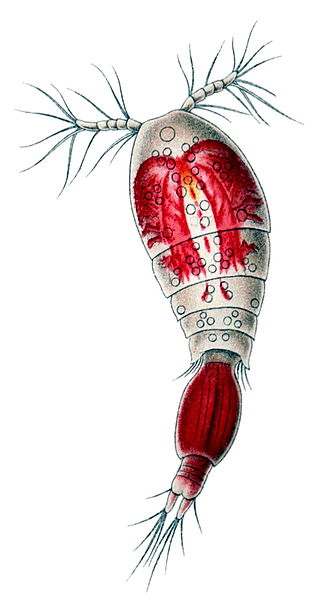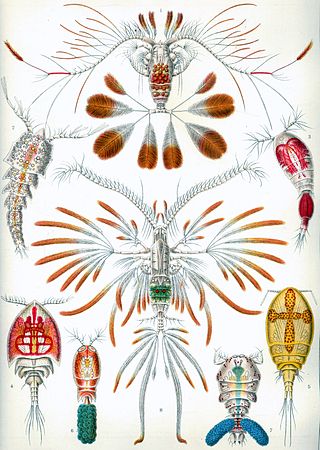
Calanus is a genus of marine copepod in the family Calanidae. The genus was split in 1974, with some species being placed in a new genus, Neocalanus. The following species are recognised:

The Hyperiidea are a suborder of amphipods, small aquatic crustaceans. Unlike the other suborders of Amphipoda, hyperiids are exclusively marine and do not occur in fresh water. Hyperiids are distinguished by their large eyes and planktonic habitat. Most species of hyperiids are parasites or predators of salps and jellyfish in the plankton, although Themisto gaudichaudii and a few relatives are free-swimming predators of copepods and other small planktonic animals.

Cyclops is one of the most common genera of freshwater copepods, comprising over 400 species. Together with other similar-sized non-copepod fresh-water crustaceans, especially cladocera, they are commonly called water fleas. The name Cyclops comes from the Cyclops of Greek mythology, as they have a single large eye; in Cyclops, the eye may be either red or black.

Oncaea is a genus of copepods. The genus contains bioluminescent species. Unlike other bioluminescent copepods, Oncaea have an internal (non-secreted) bioluminescence. Oncaea contains the following species:

Sapphirina, whose members are commonly known as sea sapphires, is a genus of parasitic copepods in the family Sapphirinidae.

Acartia is a genus of marine calanoid copepods. They are epipelagic, estuarine, zooplanktonic found throughout the oceans of the world, primarily in temperate regions.

Calocalanus is a genus of copepods, the only genus in the family Calocalanidae:

Wilhelm Giesbrecht (1854–1913) was a Prussian zoologist, specialising in copepods, during the "golden age of copepodology".
Centropagidae is a family of copepods in the order Calanoida. Its members are particularly known as plankton in coastal waters and in fresh water in Australia and southern South America. They are also found on subantarctic islands and in lakes in Antarctica.

Pontella is a marine copepod genus in the family Pontellidae. It is an organism that bears three lenses in the eye. The outer has a parabolic surface, countering the effects of spherical aberration while allowing a sharp image to be formed.

Copilia is a genus of copepods in the family Sapphirinidae. The eyes in members of this genus have two lenses, arranged like those in a telescope.

Euaugaptilus is a genus of copepods. The genus contains bioluminescent species.
Augaptilidae is a family of copepods.
Centropages is a genus of copepods in the family Centropagidae with 34 known marine species.

Artotrogidae is a family of copepods in the order Siphonostomatoida.

The clade Multicrustacea constitutes the largest superclass of crustaceans, containing approximately four-fifths of all described crustacean species, including crabs, lobsters, crayfish, shrimp, krill, prawns, woodlice, barnacles, copepods, amphipods, mantis shrimp and others. The largest branch of multicrustacea is the class Malacostraca.

Temora is a genus of copepods in the family Temoridae. The World Register of Marine Species lists the following species:
Oithona is a planktonic crustacean genus found in marine, brackish, fresh water environments. Oithona has been described as the most ubiquitous and abundant copepod in the world's oceans. It was first described by Baird in 1843 using the species Oithona plumifera as taxon type.
Temora discaudata is a copepod in the family Temoridae. It was first described in 1849 by James Dwight Dana, being placed in the Calanus genus. It was described as a member of the Temora genus in 1889 by Prussian zoologist Wilhelm Giesbrecht. The female measures between 1.68 mm to 2.05 mm in length, while the male ranges between 1.65 and 1.85 mm. It is found in the Pacific, Indian, and (marginally) Atlantic Oceans.
Rhincalanus is a genus of crustaceans belonging to the monotypic family Rhincalanidae.













